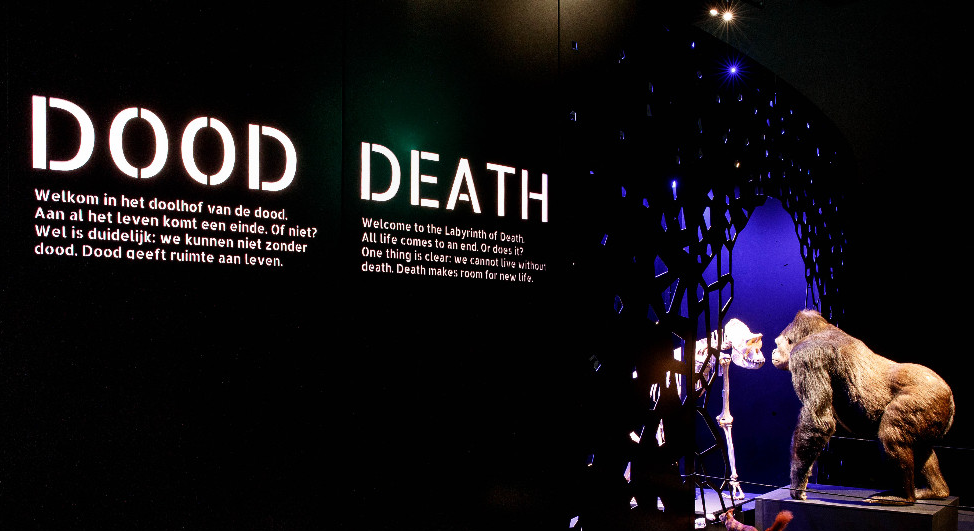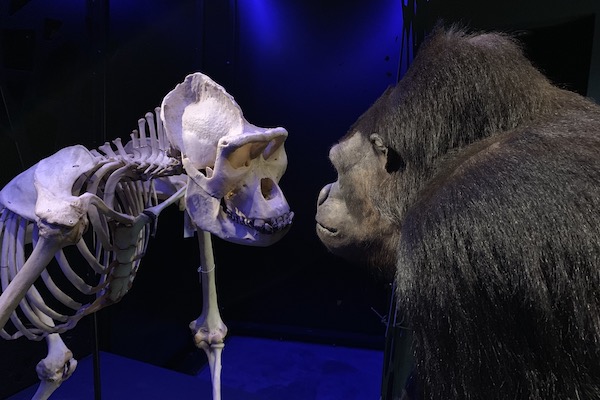Museum Naturalis presents the richness and diversity of the natural world. Spread over six floors, the visitor experiences what the Netherlands looked like in prehistory, how the theory of evolution was discovered, how shifting tectonic plates cause earthquakes and how reproduction works in the animal and human kingdoms. As billboards on the way to the museum indicate, Naturalis is also known for its impressive dinosaur skeletons. The 18 meter high Camarasaurus and the 13 meter long Tyrannosaurus Rex 'Trix' are impressive crowd pullers.
Two things stood out during our visit. First of all, it is striking how many new media forms are present. Multimedia, immersive media are everywhere. With VR glasses you can experience pollination from the perspective of the bee, you can time travel to the time of the dinosaurs in the 'Rexperience' (only to crash and barely escape the impact of a comet), hopping on With a skippy ball connected to a screen, you can compete to be the first sperm cell to reach the egg cell. Secondly, it is noticeable how the museum not only informs about nature but also gives it meaning. It highlights the importance of biodiversity and the intricate mutual dependence of life within ecosystems. Additionally, it addresses the significance of death.

On the sixth floor of the museum is the 'Death' exhibition, which provides information on what happens to the body after it dies, explaining the cycle of life and death in which organic matter is incorporated. It explicitly refers to existential questions that our physical mortality raises. This begins at the entrance of the exhibition, designed as a labyrinth. The sign at the entrance states: ‘Welcome to the maze of death. All life comes to an end. Or not? What is clear: we cannot live without death. Death gives space to life.’ Here, it is immediately opened up that the question of whether life is finite is an open one, and that there is meaning to be derived from death. This emphasis on the importance and significance of death is recurrent in the maze. Take, for example, the following installation.
In the dim light of the exhibition space, you can place your hand on an interactive screen. The contact with the screen triggers an animation. A text appears, explaining that you are made up of countless particles. An explosion of life occurs, detailing the main particles from which all life is composed (nitrogen, carbon, hydrogen, oxygen). Dying involves the rearrangement of these particles, and your particles become part of something new. This is presented not only as a biological, material fact but also as a form of comfort: ‘Whatever you become, you are infinite.’ When the visitor stands with their hand on a screen surrounded by enchanting animations conveying a sense of circular eternity, it seems not only informative but also meaningful.
This feeling is further enhanced at the end of the exhibition, where you pass through a narrow opening into an open space. Surrounded on all sides by a projection screen, the visitor suddenly finds themselves in a serene natural landscape. Bird sounds and rustling wind reinforce the feeling of being immersed in a meadow. A soundscape with elongated, swelling tones gives the whole experience both a calming and majestic quality. The projection shows and fades plants, birds, rabbits, raindrops, and low-hanging clouds that break open to reveal a bright blue sky. The seasons slowly change from spring to summer, autumn, and winter, and back to spring, placing the visitor in a cycle of life. The projection around the visitor, the sound, and the otherwise empty space all contribute to a calming, meditative experience. Thus, the exhibition on death concludes.
It shows how Naturalis Museum not only provides education and information about important life matters but also encourages visitors to reflect on the existential questions that arise from them. In various ways, the senses are engaged, adding emotional and sensory meaning to the natural history information. The natural history museum is no longer just a place where information is imparted in a detached manner; it is a multimedia space that also addresses existential questions. It uses techniques from the entertainment world, engaging people in new ways. And with the emphasis on existential questions, it also comes close to other practices of giving meaning, such as religions, where finding meaning plays a significant role.
Curious? Visit Naturalis Museum (and, highly recommended, buy a separate ticket for the Rexperience, which is comparable to an attraction in Disneyland). You can also experience how the video installation at the end of the death exhibition feels by watching the 360-degree recording of the installation below.
